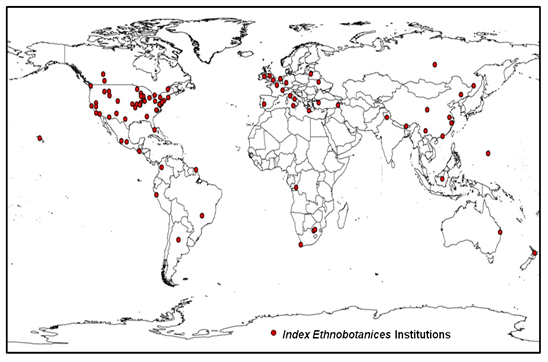-
The Garden's Biocultural Collection is a scientific reference collection located at the Missouri Botanical Garden in St. Louis. In-person visitation is by appointments only. Please contact us at ethnobotantcollections@mobot.org to request a visit.
-
Our collection catalogue can be accessed by visiting the Garden's biodiversity database, Tropicos
-
From the Main Page, find 'Specimens' on the top bar, then select 'Advanced Search'
-
To search the entire collection enter "Biocultural Collection" in the 'Keywords' field. At this point you may enter additional fields to further refine your search.
-
To locate a particular object by their unique identifier seen in images and signage, disregard the "WLBC" and enter the five digits (including all zeros, ex. 00367 or 00001) in the 'Accession #' field. This will pull up the object's record, which is organized in tabs.
Objects made from plants, or to transform plants for use, are considered biocultural artifacts. Therefore, biocultural collections include both biological specimens and the cultural artifacts more commonly seen in ethnographic and artistic collections - ranging from plant-based medicines and food to farming tools, household items, textiles, baskets, weapons, clothing, paper, and art. Together they represent a valuable resource for the understanding and conservation of humanity's biocultural heritage as well as a means of preserving traditional knowledge, documenting livelihoods, and showing the lasting influence of people - plants link to the diversity of human cultures. Just as the Garden's 7.5 million herbarium specimens are used as vouchers to the species identity of a plant, so biocultural artifacts vouch for a cultural use of a plant, and consequently, tell a story related to a particular human-plant relationship.
Biocultural objects can be found in a range of collections, such as the Garden's historic Tower Grove House, highlighting biocultural objects with object biographies throughout its online virtual tour.
Biocultural Collections are used for research by users in source communities and in a range of disciplines across the sciences and humanities such as botany, anthropology, ethnobotany, museum studies, art, and many historical studies (design, environment, collections, science, pharmacy, historical geographers, etc.)
Biocultural objects help us to understand how our own species interacts with plants and the environment, aiding in both botanical and cultural conversation, and teach us about resilience in a changing climate and increasingly globalized world. Through research we learn how intrinsically linked we are to the natural world and are reminded how plants play a critical role.
These collections are also important for education and public exhibits seen in the Garden's recently restored Stephen and Peter Sachs Museum.
The Biocultural Collections Network has over 215 member institutions including botanical gardens, herbaria, natural history, anthropology, and cultural history museums, which span the globe. The network represents a major resource for researching the interaction between people and plants.

We are actively accepting donations for our Biocultural Collection. If you are willing to donate, please download this form and return it to us at ethnobotanycollections@mobot.org. You will hear from us shortly if you item(s) is accepted.
Please complete this form to the best of your ability. Objects with no or poor provenance cannot be accepted.
Provenance: is the origin, derivation, source, and background of an object, artifact, document, etc., and includes the story of how you acquired it. Provenance is extremely important as it traces the "life history" of an object. Any photographs, documents, or recordings you have about your object or about how it relates to plants, including the plant species, creates a full understanding of its importance to people.